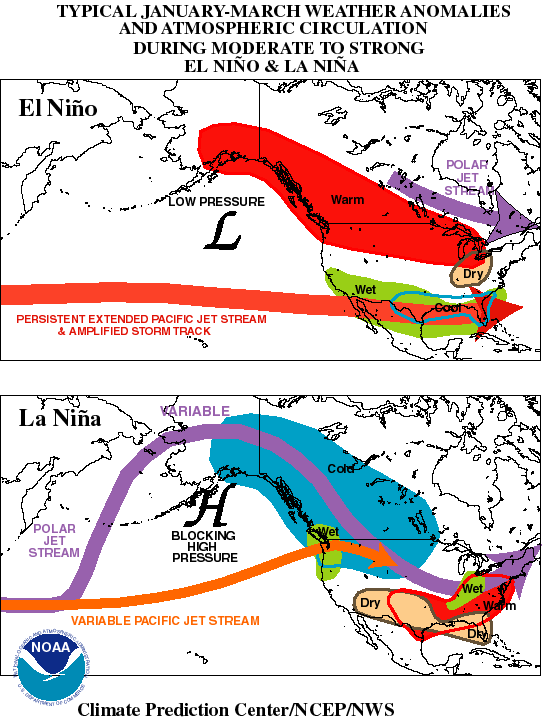
EL NIŅO AND LA NIŅA-RELATED WINTER FEATURES OVER NORTH AMERICA
 |
El Niņo episodes feature two prominent changes in the atmospheric flow across the eastern North Pacific and North America. The first is a flattening of the climatological mean wave pattern and much more zonally uniform flow than normal across the entire eastern North Pacific and North America. The second is a pronounced eastward extension and equatorward shift of the East Asian jet stream to the southwestern United States. Accompanying this flow pattern, mid-latitude low pressure systems tend to be more vigorous than normal over the eastern North Pacific and the southern tier of the United States, resulting in an abnormally stormy winter and increased precipitation across California and the southern tier of the United States. Also, there is an enhanced flow of marine air into most of North America, and a reduced northerly flow of cold air from Canada to the United States, resulting in a milder than normal winter across the northern tier of states and western Canada.
La Niņa episodes feature three prominent changes in the atmospheric flow across the eastern North Pacific and North America. The first is an amplification of the climatological mean wave pattern and increased meridional flow across the continent and the eastern North Pacific. The second is increased blocking activity across the eastern North Pacific. The third is a highly variable strength of the jet stream over the eastern North Pacific, with the mean jet position entering North America in the northwestern United States/ southwestern Canada. Accompanying these conditions, large portions of central North America experience increased storminess, increased precipitation and an increased frequency of significant cold-air outbreaks. In contrast, the southern tier of the United States experiences less storminess and less precipitation. Also, there tends to be considerable month-to-month variation in temperature, rainfall and storminess across central North America during the winter and spring seasons, in response to the more variable atmospheric circulation throughout the period.